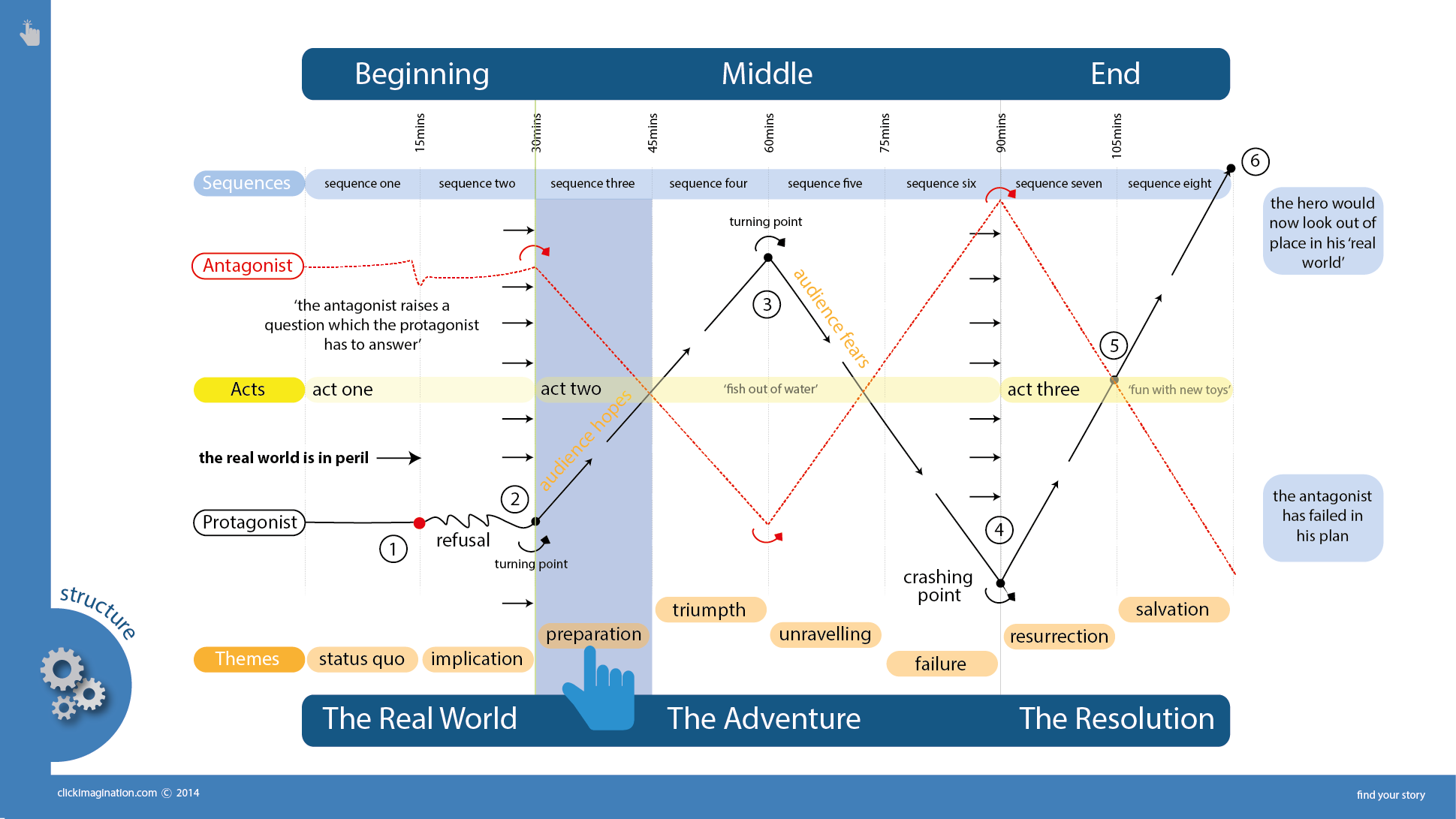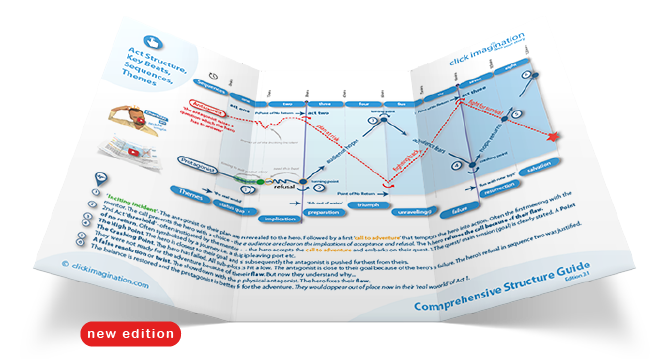Many new writers struggle with the huge white space that is 'the second act' and fall into the time-old trap of plotting to fill the void. The result is a screenplay that feels episodic and cluttered.
Want to know how to write a screenplay without losing your way? Well the first thing to do is disconnect that part of your brain that loves to plot. And don't worry, it's easily connected again! The next step is to break the screenplay down into acts, beats and sequences so story and character development builds layer upon layer. In this post were going to go deeper into screenplay structure and explore how to use themes to frame a dramatic question: for Sequences 3 & 4 by way of examples. If you've not read the posts on basic 3 Act Structure, key story beats and the mechanics of sequences then it's worth checking those posts out before you start exploring sequence themes.
The secret is to not plot until you have the story and the cast worked out. Otherwise you're setting down turning points that you'll just have to plot your way around later.
Sequences help to focus the writer (and the audience) by ensuring that the story moves forward with cohesion and avoids similar scenes elsewhere causing, duplication and repetition - i.e. making the story feel like it's been over this subject before. As covered in What Are Sequences In Screenplays, sequences are created by breaking down the story into eight, evenly proportioned blocks. Each block is 12 to 15 minutes in length depending on the run-time of the movie. Each sequence possesses their own beginning, middle and end as well as posing a dramatic question.
Using an example of The Matrix, Sequence 3 (approx 30 minutes in to the movie) is about 'Preparation' - which is a common theme. In The Matrix, this Sequence is about Neo's emergence into the 'real world' - the actual 'real world' which he has never seen. If we think of all the problems Neo will need to overcome in order to survive in the 'real world' then we simply take them and drop them into this sequence so they can be articulated to the audience as a single, cohesive group. Having a theme for each sequence makes this more apparent.

The dramatic question is answered by the end of the Sequence. In the case of the Matrix again, Sequence 3's dramatic question could be 'how will Neo survive in the real world?' Firstly, he has to build the strength in his eyes etc. Remember, he can't even see or walk when he is first pulled out of The Matrix. He can't survive on his own thats for sure - he's like a newborn - he's going to need support from crew mates and he's going to need to be rebuilt. Then, he will have to understand the geography of the 'real world' and the nature of its inhabitants etc. The answer to 'how will Neo survive in the real world' lies in 'Preparation'. The answer to the dramatic question is the Theme of the Sequence. For several reasons, it's crucial to have this sequence straight after the first act:
- This sequence conveys the rules or the world to the protagonist and audience.
- Having this information earlier would weigh down the first act.
- If this information was conveyed in the in the first act it would require exposition.
In order for the hero to ultimately prevail, they have to prepare. It's logical, therefore, that Sequence 3 'preparation' shall come before that of Sequence 4, 'the first triumph' in which the hero, protected by the mentor and team, is tested against the antagonist's army and meets with some success. Let's just take a sideways step for a moment and see these two sequences in context of the wider story structure. It's logical that, as the hero prepares for their quest, learns the rules, builds a team and trains etc. that this should be detrimental to the antagonist's plan. This is demonstrated by the rising action line for the hero being reflected by a falling line for the antagonist. In other words - the antagonist's plan is in jeopardy because of the hero's efforts.
It's important to stress that although 'preparation' comes before 'triumph', that doesn't mean the hero has nothing else to learn by the end of sequence 3. Quite the opposite. It simply means what it says, that they have been prepared - usually by the mentor figure and the allies or team. They are now fully aware of the mountain they have to climb to succeed and the rules of the world are clearly established.
If we use the example of a sports movie, this third 'preparation' sequence is usually a harsh reality for the hero. He or she understands the full extent of their opponent's skill and recognises how much they need to improve their game. There is still hope, of course, but the hero realises that in order to succeed they are going to have to work harder than they ever beleived. Once the hero is 'prepared' they must then train. In sports movies the theme of sequence 4 is typically 'training' and the opening of the sequence is heralded by a rousing soundtrack. The dramatic question of Sequence 4 in the film Rocky could be 'can he ever be good enough'. Micky herald's the close of Sequence 3 by announcing to Rocky that the secret to boxing is speed, greasy fast speed. Sequence 4 is about Rocky's brutal training regime. The sequence ends with him capturing a live chicken - thus proving to himself and Micky that he has the speed and potential. If you've not seen Rocky, I'd suggest you take a look.
Again, this is the same for Frodo in Lord of The Rings, when he meets his companions at Rivendell.
Themes have many parallels with montages. Montages are condensed and, like sequences, they allow one or multiple similar aspects of a story to be told together with a common beginning and climax. In simple terms, montages mean you can condense action by avoiding the individual scene setups (the equivalent of the first Act of the scenes) and you don't need the individual climax's of the scenes (the equivalent of the third Act of a scene). The setup is effectively shared by all the scenes in the sequence and the climax is the resolution to all scenes in one. Let's think again about a montage. The classic montage is 'training' in which we see the mentor put the hero to the test. Through a montage we see the hero growing stronger or perfecting a skill through a series of intercut clips that usually have successes and failures set to music. Montages are a hugely effective tool because, as they don't need their own setup or climax, they can convey days, weeks or even years of development within only a few minutes of screen time. Because montages are typically only a few minutes in length, they are classically set to the signature theme song of the movie. It's perhaps important to note that 'sports movies' - in the context of screenplay structure - need not actually be about a recognisable sport. The movie Eight Mile is a great example of a sports movie. Although, RAP 'battling' is unlikely to become an Olympic sport!
Download the FREE Structure Chart and Worksheet that accompany this blog and use it to test your own stories.
Ok, so let's recap on why we use themes for sequences. The title of the themed sequence provides an underlying focus to ensure that the scenes within the sequence are working to a common goal. The common goal is to answer the dramatic question of the sequence itself. The answer to the dramatic question is then carried forward to the next sequence.
Learn more about structure.

